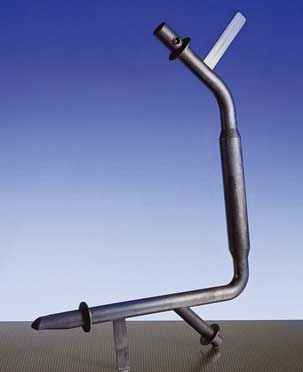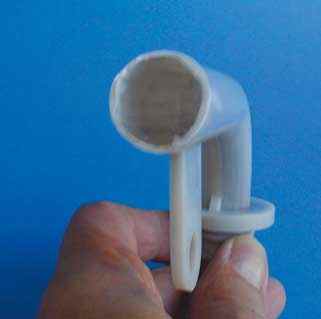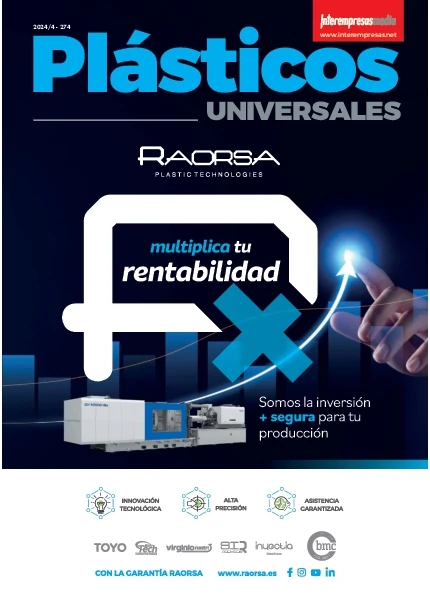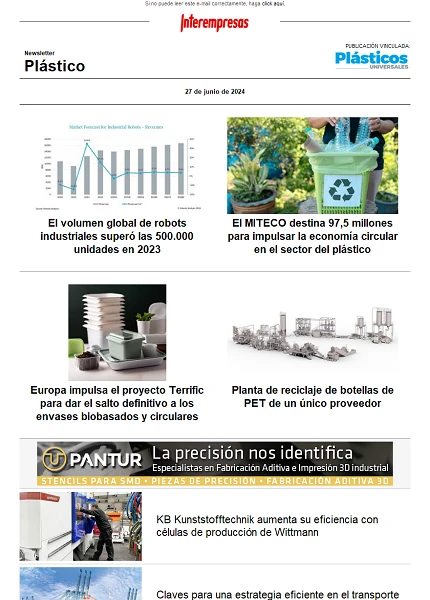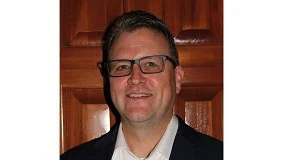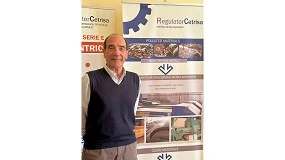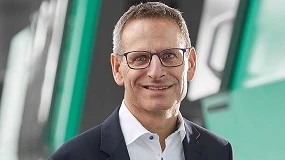This news article was originally written in Spanish. It has been automatically translated for your convenience. Reasonable efforts have been made to provide an accurate translation, however, no automated translation is perfect nor is it intended to replace a human translator. The original article in Spanish can be viewed at
La inyección con agua, lista para la fabricación en serieAt the K 2004 reputed manufacturers exhibited machines especially equipped and prepared for this innovative technique
With water injection, ready to manufacture in series
In the manufacturing industries of plastic, as well as in other industries, it is important to take any advantage over the competition, however small. The technique of injection assisted with water (WIT, by its German acronym) could make one of these advantages. Cooling times and a few minor residual wall thicknesses are the main strengths of a technique developed at the end of the Decade of the nineties at the Institut für Kunststoffverarbeitung (IKV) of Aachen, Germany, as an alternative to the method of gas injection moulding of thermoplastic parts with functional cavities.
Piece made by injection assisted with water (photo Bayer)
"The technique of injection with water (WIT) is ready for the mass production". This is the conclusion to which has been in Bayer Material Science AG, a company of the Bayer Group headquartered in Leverkusen presented several formulations of its polyamide "durethan" especially adapted for technical WIT. "With these materials can reduced cycle times between 50 and 70 percent from the injection of gas, depending on the piece", he remarks Steffen Lang, technical specialist in injection water of the Bayer Material Science AG Business-Development Department
Trials and investigations carried out so far indicate that this "wet" variant of assisted injection is indicated for the manufacture of parts enlarged with large tubular sections. Thus, their core applications can be found in the automotive industry - where can be used for the manufacture of pipes, pedals, roof bars, etc.-Although Bayer experts highlighted that the benefits of this new technique are universal and can benefit different sectors: from the furniture industry to the electricity sector or the sport and leisure industry. In this area, Steffen Lang can imagine the application of injection with water in the manufacture of armrests, seats and handles, for example.

Engel machine prepared for injection with water.
Made of water
At the beginning of 1999, the Institut für Kunststoffverarbeitung (IKV) of the University technique of Aachen, Germany, resumed and developed an "old idea" with his research on the technique of injection with water. The objective of the project was to reduce the cooling times in the manufacture of hollow bodies elongated, such as handles and duct of the engine compartment, or pieces (flat) with areas of thick-walled. To this end, the cavity of the piece would no longer conform by injection of gas, but water. In this way, trying to avoid that during the process of displacement of the melt is evaporate the medium used. The base approach was that the water is not only an excellent coolant medium, but a medium much more inexpensive, reusable and universally applicable.
Material saving is considerable: in high volume products can reach 65 percent
After receiving the "Innovation Award", awarded by the Kunststofftechnik VDI-Gesellschaft for the work done with the technique of injection with water, in November of that same year the primary responsibility for the project of the IKV in March 2002 in Baden-BadenAndre Brunswick and Tim Jüntgen, and the director of the Institute, Professor Walter Michaeli, were awarded the prestigious "Otto von Guericke-Preis" award. This award granted by the Arbeitsgemeinschaft industrieller Forschungsvereinigungen (IDA) and is endowed with 5,000 euros awarded most outstanding industrial research projects, which highlights the importance from all sectors to the new technique of injection with water.
At the ceremony of the awards, held on 28 November 2002 in Magdeburg, in the framework of the annual meeting of the Scientific Council of the AiF, they exhibited and praised the main advantages of this system of injection "happened by water". The IKV scientists have developed this innovative technique based on conventional gas injection system, but for the first time used water instead of gas as a means for the displacement of the melt. In addition to reducing the cooling times and costs, with respect to the used in the injection of gas nitrogen, the use of water also allows to reduce the residual wall thickness. The savings of material is, therefore, considerable: in high volume products might be of 65 percent, a considerable percentage, if we consider that the costs of raw materials are up to 50 per cent of the total cost of the piece.
In Magdeburg was also presented the first practical application of new technology: an innovative shopping cart basket and side elements made using WIT. This prototype, showing the potential applications of the system, was developed in the IKV in collaboration with the German supplier of raw materials a. Schulman and transforming business of plastics Suloplast, also German. The water injection can also be used to manufacture in series of tubes for cooling water and handles for plates of cutting of glass, which have to be especially resistant to deformation.
Some of the most important raw materials suppliers have been echoed in this new technique, such as Bayer and Basf
Injection: the process engine
"The basic principle of operation of the water injection is the generation of a flow rate of water large enough and a front of flow that move to the melt", as reflected in one of the technical reports published by the IKV. This flow is essential to take advantage of all the advantages offered by a liquid, so the key to this new technology is the injection of water, the most important link between the WIT and the injection mold.
Numerous tests and trials carried out by the Institute of Aachen were shown that the best system for the mass production is an injector actuated hydraulically. One such externally driven injector provides a high level of process reliability and also allows automatic recovery of water injected during the injection cycle, i.e., when the piece is still in the closed mold. As a general rule, the injected water must not remain within the piece, so it is essential that the chosen for the series production injection technique enables automatic recovery.
The water can stay initially in the piece and then removed. To this end, the piece is sealed with what is called a post-injection, dealing at the same time from the pressure of keeping. Thus, in the sobreinyección of parts can used water almost as if it were an incompressible core. The Elimination of water from the piece in the mold can be carried out by compressed air or a (partial) evaporation following pressure relief. Reclaimed water can leak into and, if it should be introduced again in the circuit.
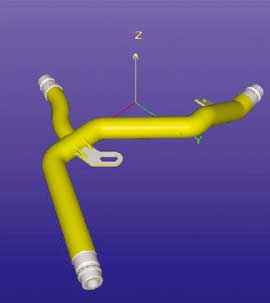
The water injection is now ready for industrial use (photo Engel).
The injection water in the manufacture in series
What should it be taken into account for change of gas injection system to a system of injection with water? According to the conclusions reached by the IKV, the first tests can be made with autoaccionados injectors. A team of injection of gas may provide gas pressure needed to push the column of water against the molten mass. However, for the manufacture in series, should be used externally actuated injectors and machines especially designed for the injection with water. In this case, the mold cooling system must be designed to injection cycles quite shorter, so not too hot accessories and slides of the mold.
Thomas Dennhardt, of the German company Pöppelmann Kunststoff-Technik GmbH & Co. KG, Lohne, recounted the experience of your company with this "liquid version" of the molding by injection assisted by fluid. It has done in the framework of the Conference, which, with the title "from development to manufacture in series", offered during the annual meeting of enterprises of molding by injection of the VDI-Gesellschaft Kunststofftechnik in early February in Baden-BadenGermany.
The company Pöppelmann, a renowned manufacturer of articles of plastic for the disparate applications, delved, with the use of this technique, in a completely unknown land. The adoption of the technique of water injection was carried out following a specific request: the company had to make various accessories for a saw chain, among them, a grip of PA6 polyamide with 30% of glass fibre. Due to the long cooling times requiring, he was discarded in the classic injection of one solid piece and was opted by a piece that had hollow form and technique of injection assisted by fluid. The company decided to bravely bet on the technique of injection with water, a relatively new technique that had not never used.
Experiences and perspectives
Dennhardt stands out as main advantages of injection with water cooling times shorter and the possibility of working with pieces of larger and smaller wall thicknesses. Naturally, the cost comparatively lower that involves the use of means of process water also a great advantage for the company. However, not all are advantages. Dennhardt points out, for example, which is necessary to adopt a large number of measures to eliminate the secondary effects of the use of water, such as the corrosion of machines and moulds. On the other hand, in comparison with the technique of injection of gas, which has for years used, the design of the injector and the configuration of the mold are more complicated. The subsequent elimination of the residual water, especially if the pieces are very curved, can extend the cycle times, so it earned for a period of cooling time can faster be losing in part here.
The conclusion that brings people of Pöppelmann after his experience with the technique of injection with water is that he is a very innovative procedure that should be seen, without a doubt, in the plans for the future. The potential for the future and the competitive advantage of the new technique should be sought, according to Dennhardt, in manufacturing parts molded with large thicknesses of wall and pipe with functional elements. In products of this type, the cooling times can be considerably reduced and can be achieved using water, high-quality surfaces and optimal Interior geometric sections. Pöppelmann also know now, from my own experience, that this technique poses new challenges to the raw materials, manufacturers, given that not all materials are, so to speak compatible with water injection.
This type of assisted injection is ideally suited to the manufacture of parts enlarged with large tubular sections
Receive the "baptism"
Some of the most important raw materials suppliers have been echoed in this new technique and hands have been to work to meet the new challenges posed by. Thus, Bayer offers two materials that have already received their "water baptism" with WIT technique with polyamide "durethan bkv 30 G" and the thermoplastic polyurethane (TPU) "desmophan 487". Next to the "Durethan DPZ-2224/30", designed primarily for the drivers hollow bodies of fluids, the above PA is part of PA products developed in Leverkusen exclusively for water injection technique. The possibility that a hydrolytic degradation to occur during the transformation process required extensive testing, which showed that, while the hot melt briefly comes into contact with water, there is no degradation of the polymer.
Distribution of the thickness of walls in twisted pieces and bar-shaped. (Photo Battenfeld)
The company Basf AG, Ludwigshafen, has also been one of the first who has decided to boost its activities in the field of injection with water. The technical applications of Basf which lead some years experimenting with this innovative technique have taken into account the special requirements of such a technical in its continuing development of technical plastics. The tests conducted have shown that the most suitable material of the House to the water injection is the "Ultradur", the polyethylene terephthalate (PBT) butylene of Basf. On prototypes such as door handles or support of windshield wiper arms could verify that it is also possible to obtain high quality parts with standard materials of the House, such as "ultradur s4090g6" or "B 4040g6", both with 30 per cent of fiberglass.
A special nozzle developed by PME is used for the injection process. PME fluidtechnik GmbH is a young company located in Sasbach, in the South of Germany, which specializes in the manufacture of equipment and technical service in the field of water injection technique. The nozzle developed by PME in collaboration with Basf is robust and compact and has already demonstrated its effectiveness in the mass production. According to experts of Basf, if reducing the cycle by more than 50 per cent time, can be amortized in less than a year the costs of investment involving the adaptation of machines to the technique of injection with water. With this perspective, it would not be surprising that this "wet" variant of the injection moulding started to soon provide a significant competitive advantage to the injectors that for her.
